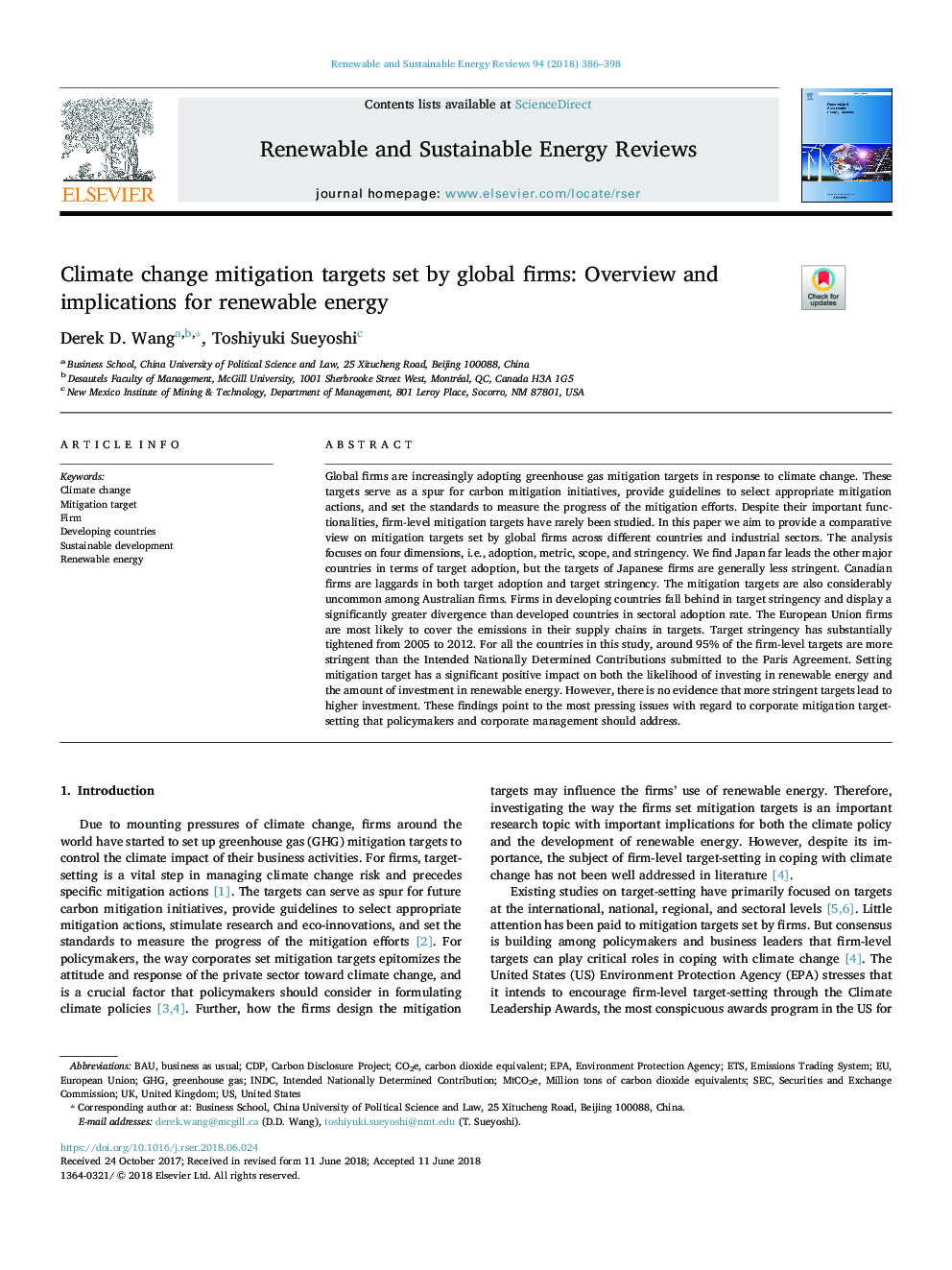| کد مقاله | کد نشریه | سال انتشار | مقاله انگلیسی | نسخه تمام متن |
|---|---|---|---|---|
| 8110438 | 1522290 | 2018 | 13 صفحه PDF | دانلود رایگان |
عنوان انگلیسی مقاله ISI
Climate change mitigation targets set by global firms: Overview and implications for renewable energy
ترجمه فارسی عنوان
اهداف پیشگیری از تغییرات اقلیمی توسط شرکت های جهانی: بررسی و پیگیری برای انرژی های تجدید پذیر
دانلود مقاله + سفارش ترجمه
دانلود مقاله ISI انگلیسی
رایگان برای ایرانیان
کلمات کلیدی
EPAIntended Nationally Determined ContributionCO2eEnvironment Protection AgencyETsCDPGHGSECBaU - BAUINDC - indcEuropean Union - اتحادیه اروپاRenewable energy - انرژی تجدیدپذیرUnited States - ایالات متحده آمریکاClimate change - تغییرات آب و هواSustainable development - توسعه پایدارEmissions Trading System - سیستم معاملاتی انتشارFIRM - شرکتCarbon dioxide equivalent - معادل دی اکسید کربنUnited Kingdom - پادشاهی متحده بریتانیاBusiness as Usual - کار طبق معمولDeveloping countries - کشورهای در حال توسعهSecurities and Exchange Commission - کمیسیون اوراق بهادار و بورسGreenhouse gas - گاز گلخانه ای
ترجمه چکیده
شرکت های جهانی به طور فزاینده ای اهداف کاهش گازهای گلخانه ای را در پاسخ به تغییرات آب و هوایی اتخاذ می کنند. این اهداف به عنوان یک پیشگویی برای ابتکارات کاهش کربن، ارائه دستورالعمل هایی برای انتخاب اقدامات مربوط به کاهش اقدامات، و تعیین استانداردهای برای اندازه گیری پیشرفت تلاش های کاهش می دهد. علیرغم ویژگی های مهم خود، اهداف کاهش دهنده سطح شرکت به ندرت مورد مطالعه قرار گرفته اند. در این مقاله، هدف ما ارائه دیدگاه تطبیقی در مورد اهداف پیش بینی شده توسط شرکت های جهانی در کشورهای مختلف و بخش های صنعتی است. تجزیه و تحلیل بر روی چهار بعد، یعنی پذیرش، متریک، دامنه و شدت، تمرکز دارد. ما متوجه شدیم که ژاپن به رغم تصویب هدف، سایر کشورهای بزرگ را هدایت می کند، اما اهداف شرکت های ژاپنی عموما کمتر سختگیرانه هستند. شرکت های کانادایی در هر دو هدف تطبیق شده و سختگیرانه هدف قرار دارند. اهداف کاهش نیز در بین شرکت های استرالیا قابل توجه است. شرکت های در کشورهای در حال توسعه در تنگنای هدف قرار دارند و واگرایی قابل توجهی بیشتر از کشورهای توسعه یافته در نرخ پذیرش بخش دارند. بنگاه های اتحادیه اروپا به احتمال زیاد به انتشار گازهای گلخانه ای در زنجیره های عرضه خود در اهداف خود می پردازند. رعایت دقیق اهداف از سال 2005 تا 2012 به مراتب شدیدتر شده است. برای همه کشورها در این مطالعه، حدود 95 درصد از اهداف شرکت در سطوح بالاتر از مقررات ملی تعیین شده در توافقنامه پاریس است. هدف قرار دادن هدف کاهش تاثیر مثبت قابل توجهی در هر دو احتمال سرمایه گذاری در انرژی تجدید پذیر و مقدار سرمایه گذاری در انرژی تجدید پذیر است. با این حال، شواهدی وجود ندارد که اهداف دقیقتر منجر به سرمایه گذاری بیشتر شود. این یافته ها نشان می دهد که مهم ترین مسائل مربوط به اهداف تعدیل شرکت ها که سیاستگذاران و مدیران شرکت باید با آن مواجه شوند، اشاره می کند.
موضوعات مرتبط
مهندسی و علوم پایه
مهندسی انرژی
انرژی های تجدید پذیر، توسعه پایدار و محیط زیست
چکیده انگلیسی
Global firms are increasingly adopting greenhouse gas mitigation targets in response to climate change. These targets serve as a spur for carbon mitigation initiatives, provide guidelines to select appropriate mitigation actions, and set the standards to measure the progress of the mitigation efforts. Despite their important functionalities, firm-level mitigation targets have rarely been studied. In this paper we aim to provide a comparative view on mitigation targets set by global firms across different countries and industrial sectors. The analysis focuses on four dimensions, i.e., adoption, metric, scope, and stringency. We find Japan far leads the other major countries in terms of target adoption, but the targets of Japanese firms are generally less stringent. Canadian firms are laggards in both target adoption and target stringency. The mitigation targets are also considerably uncommon among Australian firms. Firms in developing countries fall behind in target stringency and display a significantly greater divergence than developed countries in sectoral adoption rate. The European Union firms are most likely to cover the emissions in their supply chains in targets. Target stringency has substantially tightened from 2005 to 2012. For all the countries in this study, around 95% of the firm-level targets are more stringent than the Intended Nationally Determined Contributions submitted to the Paris Agreement. Setting mitigation target has a significant positive impact on both the likelihood of investing in renewable energy and the amount of investment in renewable energy. However, there is no evidence that more stringent targets lead to higher investment. These findings point to the most pressing issues with regard to corporate mitigation target-setting that policymakers and corporate management should address.
ناشر
Database: Elsevier - ScienceDirect (ساینس دایرکت)
Journal: Renewable and Sustainable Energy Reviews - Volume 94, October 2018, Pages 386-398
Journal: Renewable and Sustainable Energy Reviews - Volume 94, October 2018, Pages 386-398
نویسندگان
Derek D. Wang, Toshiyuki Sueyoshi,
